|
In
1962 when this Fourth National Model Rocket Championships was held,
I hadn't quite flown my first Estes model rocket; I was only four
years old. However, it wasn't too long thereafter that the bug bit
me and I was building and launching (and often losing) as many model
rockets as my meager budget allowed for. I remember seeing pictures
in model magazines like this 1963 American Modeler of big, open
space where a body could launch the largest model rockets available
in the day, and stand a reasonably good chance of recovering it
without having to climb a 50' pine tree or figure out how to get
up onto the neighbor's roof without being caught. Estes, in Primrose
Colorado might as well have been on the moon, since the likelihood
of me ever being there was just about as good. Even so, a couple
friends of mine and I managed to have a good time. My friends were
mostly into watching the fire come out of the tail end of the rocket,
whereas my own interest went much farther into the mechanics and
aerodynamics. 40 years later, I moved my own family to Colorado
Springs for a couple years and we were sure to make a trip down
to the Estes plant, but it was on a Sunday and they were not open,
so I just looked at the building and outside fixtures. Maybe someday
I'll get to go back. This NATS Was for the Birds
USAF Academy's cooperation in model rocketry makes National Championship
Meet at Colorado Springs a real going (up, that is) affair! Air
Forcers place high as boost-gliders steal show. By G. Harry
Stine
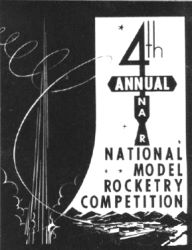 The
Fourth National Model Rocket Championships made history - and what
history! The four-day annual battle of the National Association
of Rocketry is always fun, always full of surprises. The
Fourth National Model Rocket Championships made history - and what
history! The four-day annual battle of the National Association
of Rocketry is always fun, always full of surprises. The
gang began to congregate at the Air Force Academy near Colorado
Springs, Colo., on August 22, the day before the meet got under
way. For the first time, a NARAM (NAR Annual Meet) was hosted by
an installation of the Air Force. The Peak City NAR Section, bossed
by Bill Roe, and the Academy's own Rampart Range NAR Section under
the wing of Capt. Vern van Vonderen, were co-host sections for the
meet. With help from the Academy they had built a new model rocket
range near the south entrance of the school overlooked by Pike's
Peak and the Rampart Range of the Rockies. It's a beautiful
site, perfect for flying any kind of model rocket. Processing, firing,
and launcher tables all permanent; sturdy fence around the launch
area; solid range shack that doubled as a range store during the
meet; buried comm wires to four tracking stations; roped-off prep
area; 48 (count 'em!) launchers for all kinds of birds; and 11 flagpoles.
When the meet got under way, there was a flag flying from every
pole - national colors, Colorado Flag, NAR colors, plus distinctive
range flags from 6 competing NAR sections (Peak City, Rampart Range,
Mile-High, Fairchester, North Shore, and Valley of the Sun). Add
tents for judges, scale judging, officials, refreshment stand...
Somebody contended that all we needed were horses and knights
to have it look a medieval joust. Model rocketeers turned
up from Connecticut, New York, Minnesota, Texas, Oklahoma, Kansas,
Arizona, Illinois, Wisconsin, and Utah. There were about 100 people
involved, 80 of whom were contestants. In case you're wondering
why so few, NAR had to limit the number of entrants this year or
things would have gotten out of hand. NAR aims to hold down the
number of contestants in its NARAM through elimination contests
and regional meets so that the affair doesn't get too big to manage.
Thus, only the best modelers get to come.
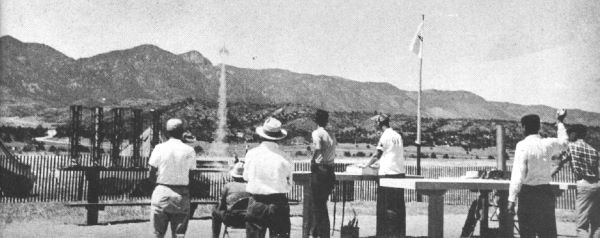
Seventeen events were scheduled.
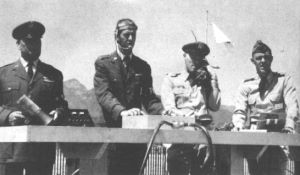
USAF'ers man firing area (from left): Capt. David Bell; Lt.
(now Capt.) Bryant Thompson; Capt. John Barnes; and meet director,
Capt. Vern van Vonderen.
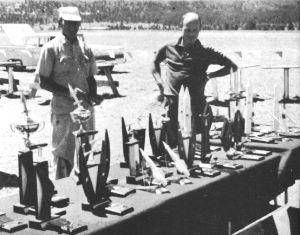
A table covered with trophies awaits winners of NARAM-4. Major
Ed Stull and Major Ted Walford brush last speck of dust off
attractive awards.
By cracking the whip Capt. Vern van Vonderen, CD, got them all flown
off. This amounts to something like 1,200 flights - which is a lot
of rocket fuel no matter how you look at it. In addition to the
usual altitude events, there were scale, scale altitude, R&D,
parachute duration, B/G duration. and Aero-space Systems events.
There wasn't as much activity in flat-out altitude this
year. Contestants are working with the tougher events which, because
of weighting factors, offer more contest points. The scale events
were just great with some beautiful models flown. Lt. Bryant "Red"
Thompson, the USAF's original "instant rocketeer," showed up with
two MX-774 missiles, one for the smaller engines and the other for
the larger Coaster Class F11 engines recently approved by NAR. Paul
Hans of Manhasset, N.Y., was flying MX-774's, too, plus a scale
replica of the NASA "Little Joe" complete with Mercury capsule.
John Essman of Denver had a Mercury Redstone. Charlie Hans, a Class
F "IRIS." Gordon Mandell of Great Neck, N. Y., a USAF "Genie," plus
a Class F "Met-roc." In the scale line-up also: AR-CAS, ASP I, Viking
#7, Viking #10, Jupiter-C, Archer, Polaris (with clear plastic fins),
and good ole V-2. There was a lot of painstaking work-manship evident
in these birds. NATIONAL ASSOCIATION OF ROCKETRY
NEW NATIONAL MODEL ROCKET RECORDS ESTABLISHED AT NARAM-4
Class B Altitude: Gary Wrightt, 2265 feot Class F Scale
Altitude, Junior: Chuck Mauro, 1510 pts. Class F Scale Altitude,
Senior: Bryant A. Thompson, 2190 pts. Open Altitude, Senior: G.
H. Stine, 980 ft. Open Payload, Senior: David E. Bell, 1700
ft. Open Scale Altitude, Junior: Paul Hans, 2810 pts. Open
Scale Altitude, Senior: Bryant A. Thompson, 2430 pts. Class
B Payload: Greg McBride, 720 feet. Double Pee Wee Altitude:
Paul Hans, 1960 feet. Class A Scale Altitude, Junior. Paul Hans
1745 pts. Class A Scale Altitude, Senior: C. S. Hans, 1460 p5s.
Boost-glide Duration, Senior: Vern Estes, 1 min 22 sec. Class
BA Altitude: Wesley Wada, 1860 feet. 1962 CONTEST
YEAR RESULTS NATIONAL CHAMPION, SENIOR DIVISION: Doug
Hylton, 357 points RESERVE CHAMPION, SENIOR DIVISION: Lt. Bryant
Thompson, USAF. 250 points (also highest Senior) NATIONAL CHAMPION,
JUNIOR DIVISION: Tom Rhue. 217 points RESERVE CHAMPION, JUNIOR
DIVISION: Paul Hans. 216 points SECTION STANDINGS,
1962 (Final) 1. Peak City, Colorado Springs,
Colo. 1912 points 2. North Shore, Manhasset, N.Y., 1000
points 3. Rampart Range, USAF Academy, Colo., 386
points 4. Fairchester. N.Y. - Conn., 350 points
5. Mile-High. Denver, Colo., 246 points 6.
Valley of the Sun. Phoenix. Ariz.,·11 points 7. Lompoc
Rocket Society, Lompoc, Calif. 2 points

(L) Denverites Greg McBride and John
Essman compare their scale Deacon and Mercury-Redstone entries.
(C) Miniature version of French Veronique powered by Coaster Class
F engine is ready to go off NARM-4 launcher. (R) Minnesota's
Manning Butterworth at Estes display manned by Brent Norlem, Bill
Simon, and Vern Estes.
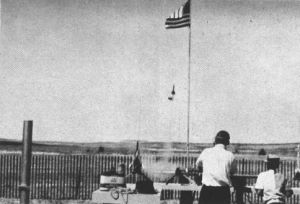
Centuri's 2-stage "Black Widow" blasts off as Leroy Piester
throws electrical switch.
All scalers powered by Type A or B engines flew pretty well, although
there was a Regulus and a Rasca1 that thrashed around the sky above
the launch area before calling it quits. Most spectacular scale
flights were by Class F models and Open Scale Altitude models, all
of which were Type F11-powered. These big powerplants worked fine
and gave some terrific flights. The Type F11-3 engine has a tendency
to sit on the pad and build up thrust for about a second before
it booms the model skyward - this is very Canaveral-ish, of course,
and lends an additional element of realism to a scale flight. Some
of the Class F birds had trouble because of the more powerful ejection
charges used... so now we know that for your recovery system you
need heavy nylon-dacron line with good knots tied in same!
Boost-glider Duration was another gasser. B/G showed up for
the first time last year; now it is an event an to itself. As predicted,
there was big rivalry between the Estes "Space Plane" and the Centuri
"Aero-Bat." B/G was flown in age divisions, Junior and Senior, as
were most of the other events except flat-out altitude. In Junior
B/G, it was Space Plane (once the younger birdmen got them trimmed
out for glide and weighted up for climb). Ted Walford, 13, son of
a USAF Academy professor, turned in 41 seconds with a Space Plane.
In Senior B/G, Vern Estes pulled a sneaky - he modified a standard
Space Plane kit so that weight was yanked out of the nose when the
engine ejected. This creation set a national record of 1:22, Vern
breaking his own B/G record. He was followed by Charley Hans flying
an Aero-Bat, Leroy Piester of Centuri Engineering turned in 53 seconds
for third flying the original, genuine Aero-Bat. Marshall Wilder
of CBS Labs, Stamford, Conn., was acclaimed this year's Instant
Rocketeer by throwing together an Aero-Bat in 85 minutes and placing
4th in the event, followed by yore correspondent with an Aero-Bat.
So the battle of the B/G kits still rages. But it sure is
a pretty sight to gee those B/G'ers go straight up, kick their engines.
and then just bang there in a glide.
FOURTH
NATIONAL MODEL ROCKET CHAMPIONSHIPS OFFICIAL RESULTS
Spot Landing (land the nose cone of a mod
nearest a marked spot): FIRST-James Scott. 14, Colorado Springs
high school student; SECOND-Yom Rhue, 15. Colo. Springs high school
student; THIRD-Paul Hans, 15, Manhasset, N.Y., high school student.
Parachute Duration (how long can a mod.,
be kept in the air with a parchute recovery system); FIRST-Paul
Hans; SECOND-Capt. David E. Bell, USAF, Andrews AFB; THIRD-Gary
Wright, 14, Denver high school student. Class B
Altitude (which free design achieves best altitude with
Type B model rocket engine): FIRST-Gary Wright; SECOND-Greg McBride,
14, Colo. Spring, high school student; THIRD--Ted Walford, USAF
Academy, high school student. Class F Scale Altitude
(which scale model goes highest with Type F model rocket engine):
JUNIOR DIVISION. FIRST-Chuck Mauro, 13, Colo. Springs high school
student; SECOND-Jim Petrenas, 15, Colo. Springs high school student.
SENIOR DIVISION, FIRST-Lt. Bryant Thompson, USAF, missile launching
officer; SECONO--Doug Hylton, 18, Colo. Springs high school student;
THIRD-Capt. David L. Barr, USAF, Air Force Academy mathematics dept.
Class BA Altitude (which two-stage model
goes highest): FIRST-Wesley Wada. 15. Denver high school student;
SECOND-G.H. Stine, research scientist. Open Attitude
(two or three stage free design for altitude): JUNIOR DIVISION,
FIRST-Tom Rhue; SECOND-Gary Wright. SENIOR DIVISION, FIRST-G. H.
Stine; SECOND-Capt. David Barr. Open Payload
(two or three stages. total take off weight 5 ounces including,
one-ounce standard payload): JUNIOR DIVISION FIRST-Jim Petrenas;
SECOND-Wesley Wada; Third-Paul Hans. SENIOR DIVISION, FIRST-Capt.
David Bell; SECOND-Capt. Davld Barr. Class B Payload
(single-staged model carrying one-ounce payload using Type B engine);
FIRST-Greg McBride; SECOND-Gordon Mandell, 15, Syosset., N.Y., high
school student; THIRD-G. H. Stine. Double Pee Wee
Altitude (two-staged models with very limited engine power):
First-Paul Hans; SECOND-Gordon Mandell; THIRD-Chuck Mauro.
Scale (exact scale models capable of flight,
judged on adherence to scale, workmanship, degree of difficulty,
and flight characteristics): JUNIOR DIVISION, FIRST-:-John Essman,
16, Denver high school student; SECOND-Dick Roebken, 14, Colo. Springs
high school student; THIRD-James Scott. SENIOR DIVISION, FIRST-Lt.
Bryant Thompson; SECOND-Capt. David Barr. Plastic
Scale (non-flying plastic scale models adapted for flight
from commercial kits): JUNIOR DIVISION, FIRST-Paul Hans; SECOND-John
Essman; THIRD--Gordon Mandell. SENIOR DIVISION, FIRST-G.H. Stine.
Aero-space Systems (scale model or USAF
missile which must carry standard payload, land near an assigned
spot, be launched on a few minutes' notice): JUNIOR DIVISION. FIRST-Paul
Hans; SECOND-Gordon Mandell; THIRD-Chuck Mauro. SENIOR DIVISION,
FIRST-Lt. Bryant Thompson; SECOND-Doug Hylton; THIRD-G. H. Stine.
Research & Development (open to designs
of any type to stimulate new concepts, new approaches. and new ideas):
JUNIOR DIVISION, FIRST-Hans-Scott Team (Paul Hans and Don Scott,
16, Port Washington, N.Y.); SECOND-Wesley Wada; THIRD-Gordon Mandell.
SENIOR DIVISION, FIRST-Doug Hylton; SECOND-Lt. Bryant Thompson;
THIRD-Capt. David Barr. Pee Wee Altitude
(free design using very limited engine power going for altitude):
FIRST-Chuck Mauro; SECOND-Ronney Webster, 13, Saline, Kans.; THIRD-Charles
Hans, Manhasset, N.Y., motion picture executive.
Class A Scale Altitude (exact scale models flown
for altitude with Type A engine): JUNIOR DIVISION, FIRST-Paul Hans;
SECOND-Don Scott; THIRD-Gordon Mandell. SENIOR DIVISION, FIRST-Charles
Hans; SECOND-Doug Hylton; THIRID-Lt. Bryant Thompson.
Boost Glider Duration (for models which takeoff
vertically but glide down with wings.) JUNIOR DIVISION, FIRST-Ted
Walford; SECOND-John Essman; THIRD-James Scott. SENIOR DIVISION,
FIRST-Vernon Estes, president of Estes Industries, Inc.; SECOND-Charles
Hans; THIRD-Leroy E. Piester, president of Centuri Engineering Co.
R&D was wild one, per usual. Paul Hans and Don Scott
of Long Island flew their movie camera rocket which got pictures
using an F11-3 engine: this time they will send the movie film to
the processing labs with a special plea not to lose same. Wes Wada,
15, of Denver, demonstrated a balanced rudder for B/G that keeps
his bird headed into the breeze. Gordon Mandell unveiled a suitcase-full
of B/G birds that he had used to work out proper aerodynamic parameters.
In Senior R&D, Doug Hylton cooked up a way to double the duration
of commercial engines without altering them which took first prize.
Red Thompson flew his 3-stage bird that was designed to eliminate
Krushnic Effect... and it did. Capt. Dave Barr of the Air Force
Academy proved again that by filching fletching feathers from arrows
you can make good fins. But Capt. Dave Barr from Andrews AFB found
out paper fins aren't beefy enough! This was the first year
for model rocketry's most demanding contest event, Aero-space Systems.
And it was tough! Requirements: a scale USAF missile carrying a
standing NAR Pay-oad with its own launcher and firing system, flown
on 15-minutes' notice against a target for spot landing with minimum
flight altitude of 200 feet. Paul Hans, flying MX-774 took it for
Junior Division followed by Gordon Mandell, who got his USAF "Genie"
off the ground with but 5 seconds time left. In Senior Division,
it was the nerveless competitor-survivor of many major airplane
contests, Lt. Thompson, who took first with an MX-774, followed
by Doug Hylton and Old Rocketeer Stine flying Pogo-Hi in third.
This one is rugged, boys; your bird lies there in the launch area
with no engine and no igniter. In 15 minutes, you've got to load
it, install an igniter in it, get on the launcher, hook it up, take
a wind reading and make corrections, finally push the little button
and pray. It may sound easy, but try it under the pressure of a
running clock! And varying winds. And a couple of misfires. Whew!
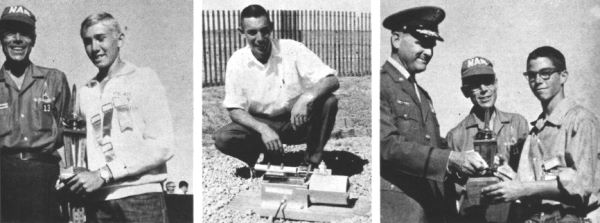
(L) Senior/Leader Champ, Doug Hylton, 18, of Colorado Springs with
Chairman Bill Roe. (C) New recording static test stand from
Rocket Development Corp. & Irv Wait. (R) NAR Junior Champ
Tom Rhue, 15, gets award from Major Gen. Robert Warren.
"Plastic Scale" turned out to be a good event, too. It is not
too easy to find a scale plastic missile kit that can be modified
for flight, and it is not simple to make the modifications, either.
Capt. Dave Bell found out that you don't put nose weights in a plastic
model using regular cement... first cork-screw nose I ever saw on
a model! There were Revell V-2's, Hawk Corporal's, Revell Corporal's
and Revell X-17's in the line-up that flew. Gordon Mandell had a
tough time finding his camouflage-painted V-2 after it landed, it
blended in pretty well with the sage brush. In addition
to doing a lot of rocket flying in excellent weather, we accomplished
other things, too. The usual bull sessions were in progress continually.
We toured through the Academy's aerodynamics and propulsion labs,
where everybody wished they had access to the wind tunnels and static
test stands for model testing. The guide was rather hard-pressed
to answer some of the technical questions that were tossed at him
by the contestants who, after all, had experience with the practical
aspects of rocket engines and aerodynamics! We toured the blockhouse
at the North American Air Defense Command (NORAD) and watched the
Academy Cadets parade.
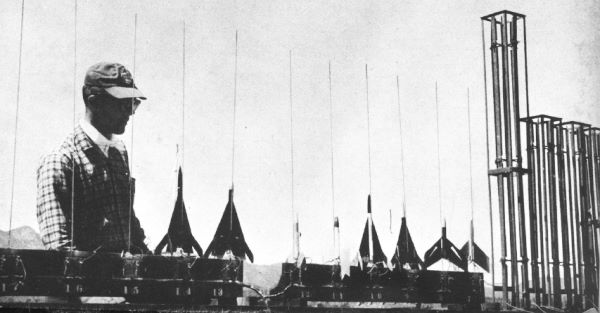
Contest Director for NARAM-4, Vern
van Vonderen, hooks up a launcher rack of boost-gilders. These
winged rockets glide back to earth after "shoot."
This was also the first time that every model rocket manufacturer
was in one place at the same time. They were all there seeing what
the rocketeers were doing with their products - Menford Sutton of
Coaster Corp., Vern Estes of Estes Industries, Leroy Piester of
Centuri Engineering, Irv Wait of Rocket Development Corp., and Skip
Keller of Model Missiles. This gang not only put on a sky-busting
manufacturers' demo on the final day of the meet, but were on hand
to answer a million questions by the rocketeers. The Model
Rocket Manufacturers Association was formed during NARAM-4; all
the commercial types got together in an organization to enforce
ethical practices, promote safety standards, and exchange information.
A long time in coming, this should mean better model rocket products,
NAR and manufacturers are now working together to advance this hobby
and solve its remaining problems. Since it is the manufacturers
who make model rocketry possible on our safe-and-sane scale, herewith
a report on what they displayed... Estes Industries had
a three-D tracking reduction system, a wind tunnel, a simple static
test stand, a simple tracking station, lots of models, and printed
material on hand with Ole Vern, Brent Norlem, and Model Rocket News
hound Bill Simon presiding. Centuri Engineering Company
was represented by Leroy Piester and his wife, Betty, who showed
off their Aero-Bat B/G, their new Arcon kit, their launcher, and
their line of model rocket supplies; the Centuri "Mini-Max" model
rocket engines are still in the development stage.
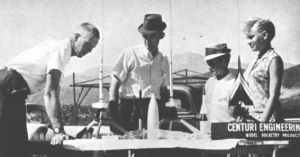
USAF's "Red" Thompson, skilled air-modeler now excelling in
model rocketry, checks Centuri exhibit with firm's Leroy, Kenneth
and Betty Piester.
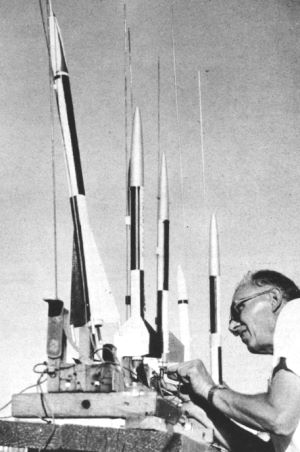
Class F Scale Altitude entries get final check by Charley Hans.
Shown are ASP, two NASA IRIS, USAF MX-774, and at end of line-up,
another ISIS.
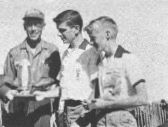
Don Scott, Paul Hans (rt.) get Huyck R&D trophy; Bill Roe
beams approval.
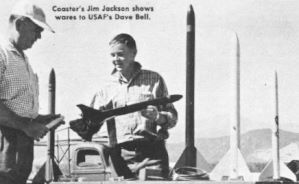
Coaster's Jim Jackson shows wares to USAF's Dave Bell.
Two lovely little recording static test stands were shown by Irving
Wait of Rocket Development Corp. ROC test stands, model rocket equipment,
and engines are available from this new Utah firm. To us the ROC
stands look like the greatest thing since electrical ignition; you
can get beautiful thrust-tune curves from them, and we used Irv's
stands to check the performance of the many types of model rocket
engines that were available for sale on the range for contest use.
Skip Keller of Model Missiles, Inc., showed the reliable
Aerobee-Hi and Arcon kits, and they turned in the sort of perfect
flights for which these model rockets are known-straight up with
parachute deployment exactly at peak altitude. Menford Sutton
and Jimmy Jackson of Coaster Corporation had all their models on
display - Satum, Space Probe, Mercury, and their new "Centauri"
B/G-along with firing panels, launchers, chutes, and engines. Jimmy
flew each of them, some with 35·pound engines. The Coaster B/G is
a big one, should take small R/C gear with no sweat. Although Coaster
F11 engine sits on the pad building up thrust while its slow-burning
propellant gets going, the 35-pounder lights right off and gits.
NAR is now testing the 35-pounder for contest use. As with
most any contest, some gripes turned up. But Bill Roe had a system
for holding them down. Each contestant was given a little pink card.
"NARAM-4 MOM-WATS," to be presented to an official if so requested
and ten small squares for punches. Each judge carried a railroad
conductor's punch to use with the standard NAR punch-card contest
scoring sheets. Each time some guy came up with a tale of woe or
a gripe, a judge would hear him out, render a decision, then punch
his MOM-WATS card. (Confession-I collected five punches.) At the
end of the meet, Steve Kushnir, 15, of Colorado' Springs totaled
13 punches on his card and was presented with a huge bath towel
inscribed "NARAM-4 Crying Towel." What does MOM-WATS mean?
"My Oh My, What A Tough Situation!" They worked, helping
make light of several tough situations, gently reminding everyone
that this was a sporting contest and not the end of the world.
There was a table full of trophies, one for each event with
duplicates for age divisions and a plaque for each second place.
All of the model rocket manufacturers coughed up trophies in addition
to the Martin-Marietta Corp., Systems Development Corp., The Air
Force Association, Revell, Inc., Holly Sugar Corp., and Huyck Corp.
There were even two Ford sedans and a Ford pick-up, but they were
just "official cars" for use during the meet... they wouldn't let
us take them home as samples! America's high-point senior
model rocketeer was Red Thompson who had worked hard all year and
battled his way through the USAF's own meet for its service personnel
at Lackland AFB. Red's long experience in model plane contests paid
off well for him; he knew what to do and how to do it... and he
did a good job of it. On top of that, he could call on his professional
USAF experience as an Atlas ICBM launching officer! He didn't cop
the Senior Championship, however, Doug Hylton took that.
Doug is an NAR Leader Member, 18 years old, But since he was
the only such member in NARAM-4, he could not compete against himself
for Leader age division honors. So the Contest Board allowed him
to compete with the older Seniors. He was also the 1961 National
NAR champ and had been racking up contest points all year. Nobody
could touch him in contest points or in his ability to build excellent
contest models (although the Seniors gave him a tough race). Doug
just finished high school as an honor student, plans to go on to
engineering. Junior Champ was a close race between Tom Rhue
and Paul Hans, both 15. They fought this one down to the wire. In
fact, it was so close that Tom won by only one point! "Tom should
have it anyway," Paul told me later. "He missed the 1961 championship
by but one point. I'll get it next year because I'm starting right
now!" The Champ Section pennant will fly for another year
over the range of the Peak City Section in Colorado Springs. The
runner-up, North Shore Section of Long-Island, is gunning for it
in 1963! The Air Force Academy's Rampart Range Section ran third
with the New York-Connecticut Fairchester Section in fourth place.
The Battle of East vs West should be something to watch this coming
year; the East Coast rocketeers are out to show the cowboys how
to build model rockets! It's also going to be interesting
to observe the Air Force boys again. With Red Thompson, Dave Barr.
and Dave Bell leading them as seasoned NARAM veterans, plus Carl
Klauck (stationed at Thule, Greenland and flying in the snow). Vern
van Vonderen, Ed Stull, John Barnes, the fellows who flew at Lackland,
plus some others who didn't make it this year, we oughta see a great
surge of model rocket interest in the USAF. After all these years
of trying to get a model airplane trophy, Air Force modelers finding
that they are much better in model rocketry and it's easier to transport
and store their miniature birds. A slug of national
model rocket records were established or surpassed at NARAM-4. Gary
Wright, 14, of Denver hit 2265 feet with a single-staged bird powered
by a Type B.8-6 engine to take the Class B Altitude record. This
with only 1.15 pound-seconds of total impulse! Theoretically, it's
impossible. Dave Bell went 1700 feet for an Open Payload record,
Senior Division. Red Thompson set two new Senior records - Class
F Scale Altitude and Open Scale Altitude. Paul Hans did 1960 feet
in Double Pee Wee (Type A lower stage, Type half-A upper stage),
and Wes Wada cracked 1860 feet in Class BA Altitude. The Old Rocketeer
set a Senior Open Altitude record of a paltry 980 feet (Junior record
is 2440 feet!) flying a beat-up 4-year-old Li'l Mark with an MMI
Booster equally as old (excuses, excuses); I was the only one who
got tracked because some of the other super-duper clustered 3-stagers
were all over the sky. And I flew just for points. Shows what will
happen if you don't watch out. Yes, we also flew some
chicken eggs! It was an unscheduled event with no prize, but we
tried just for fun. The object: fly a fresh, Grade A hen's egg without
cracking the shell or scrambling the yolk. Dave Barr made an omlette
when his chute failed to deploy. Yours truly scrambled one, I had
them bury the whole mess because my chute didn't come out, either.
Paul Hans and Don Scott of Long Island tried it with
an egg in place of the movie camera in their Class F camera bird.
On first try. the model jammed on the launcher, finally scraped
free, and lobbed itself over the launch area fence, clearing it
by about six inches and landing in soft sand. The egg was unbroken,
but all agreed that wasn't really a proper egg flight. So they jammed
(and I do mean jammed) the egg back into its foam rubber acceleration
couch, sealed the capsule, put in another F11-3 engine, oiled the
launch rod, and this time, it worked! Model went about 500 feet,
capsule and booster came down on separate silk parachutes, chickennaut
landed gently, egg was unbroken. yolk unscrambled. Hans and Scott therefore became first to fly an egg successfully.
Another historic milestone in the space race has been achieved!
(If you think this is easy, just try it! And it's much more fun
than flying mice.) We hear that Hans-Scott are going
to fly another egg, hatch it, and have an egg from that chicken
to fly next year, and so on, thereby breeding a strain of rocket-powered
chickens which they will enter in the B/G events to the consternation
of the judges. We can see it all now as the chicken ejects from
the nose cone and starts to glide... "Disqualified? But, sir! The
rules don't say we can't!" After Major General Robert E.
Warren, superintendent of the Academy, had presented all the trophies,
everyone gathered up their gear and started the homeward trek. We'd
missed meals, lost sleep, gotten sunburned, and had a fine collection
of scrap balsa in some cases. But NARAM-4 was the biggest meet ever.
Accident-free, per usual. Model rocketry had really advanced in
a year - B/G's hovering in the sky, Class F engines, B3 engines,
nichrome igniters, new manufacturers, new faces, new models, and
new ideas galore. CAP getting into the act and USAF more active
all the time. NAR membership up 300% in 12 months, Model airplane
builders and amateur rocketeers switching over to model rocketry.
New vistas and new challenges galore as model rocketry begins to
specialize - experts in parachutes, B/G, scale, and staging, to
name a few. To your correspondent it is even more
amazing because we can still remember flying our first model rocket
in a New Mexico cotton field in early 1957 long before anybody thought
of NARAM. Now we observe guys who live thousands of miles apart
and who have never met before, strike up a conversation about model
rocketry where everybody knows exactly what the others mean.
So now the big cry is: "On to NARAM-5!"
Posted December 11, 2011
|




